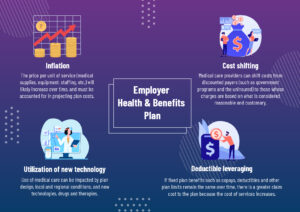
Understanding Trend and the Impact on your renewal
Market Overview and Update
The health care industry continues to evolve. Employers are challenged with absorbing health insurance increases and other impacts to their bottom lines. In addition, complying with the Affordable Care Act (ACA) brings added uncertainty and financial burden. However, employers can take solace in the fact that the market is experiencing a slowing underlying cost growth—that is the cost increase that employers would expect to see if they made no changes to their current medical plans.
As the Affordable Care Act takes greater hold in the marketplace against the backdrop of an improving economy, it is unclear whether health plan cost trends will continue to decline or return to the historically inflationary underwriting cycle.
To mitigate the budget squeeze resulting from these increases, employers are forced to focus more than ever on health care cost management. Strategies identified by the survey include investments in wellness, care management, value-based plan designs, data mining and discounted provider networks.
What is Trend?
One of the factors in calculating any future increase is called trend.
Trend is a prediction of how much health care costs will rise over the next policy year. It is one of the factors used to calculate renewal rates for health plans and stop-loss insurance. Each year, carriers set their own trend level based on various factors, including the current health care inflation rate, analysts’ forecasts and their own experiences. It is important to note that the trend rate is not the same as the actual renewal rate, though trend does play a role in how the carrier determines the annual plan cost.
Carriers typically determine trend by taking into account the “experience period” (the known claims experience) and the “projection period.” Claims are trended using the midpoint of the experience period (six months of claims) to the midpoint of the projection period (six months of projected claims). For example, if the policy period is January 2018 to December 2018 and the renewal projection is utilizing claims experience from October 2016 to September 2017, you need to account for the additional months of claims in 2015 that are not included in the renewal projection. Therefore, in the following example you would utilize the annual trend factor multiplied by 15 months (to include the months not accounted for in the renewal projection).
There are four main components of trend. These elements are common across the risk spectrum, although you will see that the impact of any given component will vary widely depending on which level of risk is being evaluated (e.g., first dollar coverage, consumer-driven options or catastrophic risk). Each element of trend needs to be viewed on a standalone basis.

- Inflation: The price per unit of service (medical supplies, equipment, staffing, etc.) will likely increase over time, and must be accounted for in projecting plan costs.
- Cost shifting: Medical care providers can shift costs from discounted payers (such as government programs and the uninsured) to those whose charges are based on what is considered reasonable and customary.
- Utilization of new technology: Use of medical care can be impacted by plan design, local and regional conditions, and new technologies, drugs and therapies.
- Deductible leveraging: If fixed plan benefits such as copays, deductibles and other plan limits remain the same over time, there is a greater claim cost to the plan because the cost of services increases. For example:- Year 1: $2,500 claim minus $250 plan deductible = $2,250 paid claim- Year 2: $2,850 claim (increased by 14 percent trend) minus $250 plan deductible = $2,600 paid claim
Trend is a complex concept that takes into account many interacting factors, including historical experience and future estimates. Its influence on determining medical plan costs makes it an important concept to know and understand. Your medical carrier should be able to provide you with even greater detail on its trend determinants, as they can vary widely by plan design type and location.
Please contact TechServe Alliance for help with examining your organization’s plan design(s) and for recommendations for improvement.
